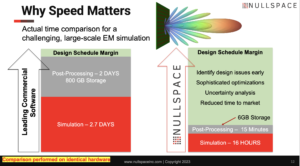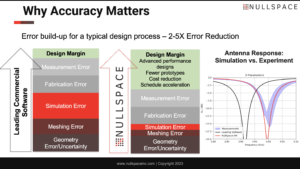
EDACafe Editorial Roberto Frazzoli
Roberto Frazzoli is a contributing editor to EDACafe. His interests as a technology journalist focus on the semiconductor ecosystem in all its aspects. Roberto started covering electronics in 1987. His weekly contribution to EDACafe started in early 2019. Startup Nullspace offers over 25x faster EM simulation for antenna and radar designAugust 3rd, 2023 by Roberto Frazzoli
Flagship product of the new engineering software company – a spinoff from defense contractor IERUS Technologies – is an electromagnetic simulation software that has been tested on real-world antenna, microwave, and scattering problems for the last twelve years Wireless applications are getting ever more complex in several key industries such as defense, aerospace, 5G/6G communications, and automotive. Some of the design challenges concern multi- and wideband antennas, active and passive electronically steered arrays, MIMO antennas with complex beamforming, complex microwave networks, cosite interference when multiple antennas are placed on vehicles or aircrafts, and more. Companies developing advanced communication systems rely on electromagnetic simulation software that must combine speed, accuracy and flexibility, to reduce the development time while avoiding design errors.
Are market leading software products up to the expectations of engineers designing the most sophisticated antenna and radar applications? Twelve years ago Dr. Daniel Faircloth and his team – designing complex electromagnetic devices for defense and aerospace at defense contractor, IERUS Technologies, in Huntsville, Alabama – was unsatisfied with the EM simulation products available on the market and started to develop a new tool in-house from the ground up. The resulting software, called Nullspace EM, has been tested by IERUS on real-world antenna, microwave, and scattering problems for the last twelve years, in the development of RF hardware for its military customers. Recently, IERUS decided to offer its electromagnetic solver to the market – along with other two software products – spinning off this part of its business through the creation of a startup company called Nullspace. The birth of this new challenger seems to be a potentially disruptive event for the electromagnetic simulation market, as Nullspace claims over 25x faster simulation at same or better accuracy than market leading products. Nullspace CEO, Dr. Masha V. Petrova discussed the company’s offering in the video interview she recently gave to EDACafe’s Sanjay Gangal; in this article we will add some details, based on the answers Petrova provided to some additional questions. The recipe for faster electromagnetic simulation According to Dr. Petrova, Nullspace EM simulator achieves its outstanding performance in terms of speed and accuracy through a unique combination of mathematical techniques, compression algorithms, and its native capability to take advantage of multiprocessor hardware acceleration. The tool uses method of moments (MoM) formulation, high-order geometry (HOG) and high-order basis functions (HOBF). “Some of the competitors use some combination of HOG and HOBF. But none use it like us, while also combining both techniques with compression algorithms and CPU and GPU acceleration,” said Petrova. “Our solvers are built on a method of moments (MoM) surface integral equation (SIE) formulation and provide for the solution of arbitrary complex body problems at large scale,” she added. “They utilize proprietary implementations of low-rank exploiting algorithms to compress both the matrix fill and LU decomposition – achieving scalability and performance for large, complex problems.” The other ingredient for speed is native multi-CPU and multi-GPU acceleration capability. “This requires defining the software architecture and underlying algorithms from the start to leverage these technologies. Bolt-on solutions will always be less efficient,” Petrova commented. According to the company, GPU acceleration in particular is a feature that distinguishes Nullspace EM from other vendors’ solvers: “As far as we’re aware, their use of GPU is nonexistent, fairly minimal, or locked behind paywalls”, Petrova added. The latest Nullspace EM release has direct support for Pascal, Volta, and Ampere GPU architectures. GPU and CPU acceleration is built into the tool’s floating licensing structure – which comes with out-of-the-box licensing. In terms of flexibility, a key feature of Nullspace EM is its Python scripting interface. According to the company, this enables users to control the simulation process from CAD import/creation to visualizing results and simplifies the connection to other software packages. “Other products have Python APIs, but we believe our API structure is more flexible. Our software was designed from the ground up with optimization and parametric analysis in mind in a way that gives engineers the most flexibility to customize their workflows,” Petrova commented. Performance comparisons with leading commercial EM simulation tools As we already saw, Nullspace EM has been internally tested by IERUS working for its military customers. But over the past few years the product has also been adopted by some external users: “While Nullspace was still part of IERUS, before spinning-out as an independent company this year, it already had several customers – including leading government labs and defense organizations,” Petrova explained. This is the reason why Nullspace EM already boasts some customer endorsements: Georgia Tech Research Institute found that their model/measurement agreement was so good that they were able to eliminate the need for further prototyping; and a leading government research lab completed a specific test model in six CPU-hours, as opposed to 132 CPU-hours – for the same problem, with the same mesh – using an established commercial simulation tool. Another performance comparison was provided by Dr. Daniel Faircloth, CTO of Nullspace, in a presentation he gave on the occasion of the International Microwave Symposium 2023. The example concerns a large finite phased array in an 11 by 11 grid. Each element of the array is a dual feed patch antenna, so the total simulation is 242 excitations. The goal set for the simulation was the solution for the fully coupled element patterns and the ability to synthesize array patterns for any arbitrary combination of weights. The same analysis was performed on identical computing hardware with an expert user of a leading commercial software package and an expert user of Nullspace EM. The simulation using the leading software required 2.7 days to complete, compared to Nullspace EM’s 16 hours. The time required to synthesize a single beam pattern using the leading software required two days, and at the end of the two days the simulation and pattern data together had consumed 800 gigabytes of hard drive storage; meanwhile Nullspace EM produced all far-field data required to synthesize any beam pattern in only 15 minutes and required only 6 gigabytes of storage. As Faircloth pointed out in his presentation, a reduction in simulation times allows engineers to devote more time to additional investigations, such as weights optimization, beam steering error analysis, or uncertainty analysis, identifying design issues early. The other aspect emphasized by Faircloth in his presentation is the need to retain extreme simulation accuracy even with high simulation speed, to gain a wider design margin despite the error build-up due to various sources of error in the design process. Nullspace Prep, a CAD and meshing tool for Nullspace EM Nullspace product offering also includes a tool devoted to EM design engineers: Nullspace Prep, a CAD and high-order meshing pre-processor which integrates with Nullspace EM (and with the company’s quantum computing tool, as we will see in the next paragraph). Nullspace Prep was developed in partnership with Coreform, developer of Coreform Cubit and Coreform IGA. According to the company, it provides a streamlined progress from CAD to analysis, with full-featured capabilities for geometry preparation and mesh generation, analysis, and fine-tuning. Nullspace ES, a tool for quantum computing design Besides antenna and radar design, Nullspace is also targeting the nascent quantum computing market. Completing the current Nullspace product offering is Nullspace ES, what the company claims is the world’s only commercial electrostatic solver for extremely large-scale design and analysis in quantum computing. “Nullspace ES is a separate product for the quantum computing industry, specifically for ion trap design,” Petrova explained, “the underlying solver is based on the same advanced algorithms and architecture as Nullspace EM. However, Nullspace ES rigorously solves the exact physics required to realize ultra-large-scale trap designs previously unachievable.” Nullspace ES can also be integrated with the Nullspace Prep pre-processor. A startup company challenging established market leaders Headquartered in Irvine, California, startup Nullspace can count on backing from IERUS and initial seed funding of $500K. As Dr. Petrova explained in the video interview, the company is looking for its series A funding or another seed round. The three co-founders (which include IERUS CEO, Jason Keen, besides Daniel Faircloth and Masha Petrova) all hold PhDs in electromagnetics and aerospace engineering, and all have 10+ years of commercial and executive leadership experience. Nullspace also has a group of advisors with defense, finance, R&D, and entrepreneurial experience. Dr. Petrova is optimistic about the growth potential of Nullspace, even though the company will have to compete with large and well-established software vendors and their well-known products – such as Ansys’ HFSS, Dassault’s CST, and Altair’s Feko. “Competitor products from the likes of Dassault Systems and Ansys certainly have their place. They provide the breadth of multiphysics capabilities necessary for today’s product design and analysis,” Petrova conceded. “That said, Nullspace was developed from the need of IERUS’s engineers for faster tools that would not get ‘stuck’ while solving electrically-large EM problems and that could be used in flexible, customizable engineering workflows along with other optimization tools, uncertainty analysis, and parametric studies. Oh, and that wouldn’t cost an arm and a leg! All these challenges certainly seem to resonate when I speak with engineers in other companies!”, she added. “The biggest challenge for us is that we’re the new kid on the block. The biggest pushback that we’ve gotten so far is an ‘it seems too good to be true’ response. Engineers have a hard time believing that a tool they’ve never heard of, might be that much faster and more efficient and just as accurate, or more accurate in many cases, than the legacy tools. As PhD engineers ourselves, we completely understand and welcome that healthy skepticism. That’s why we’re happy to set-up online demos and provide free trials of our tools to any qualified potential users! We’re also launching our Academic Program with very affordable academic pricing to help spread the use of Nullspace software in the research community,” Petrova concluded. More information and tutorials about Nullspace products can be found on the company’s Youtube channel. Categories: EDACafe Editorial, Video Interview |
|
|
|||||
|
|
|||||
|
|||||








